Unmanned death
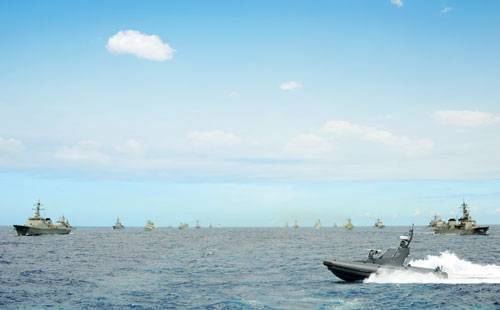
Israel is a very small country that relies on very large fists. Its military equipment can give odds to Russia and the United States. Recently, in the press, there were photos of the new know-how of Israel - Rafael unmanned boat Protector patrolling the coastal area of Syria, Lebanon and even Iran. Editorial "PM" decided to understand the topic of unmanned naval battles.
Unmanned boats are a pretty old idea. The first about the prospects for military boats-drones Nikola Tesla wrote in his book My Inventions (1921). “They will definitely be built, they will act based on their own intelligence, and their appearance will revolutionize the military sphere…” he wrote. As for intelligence, the great scientist, of course, got excited (although who knows what awaits us in the future), but the rest was predicted quite correctly.
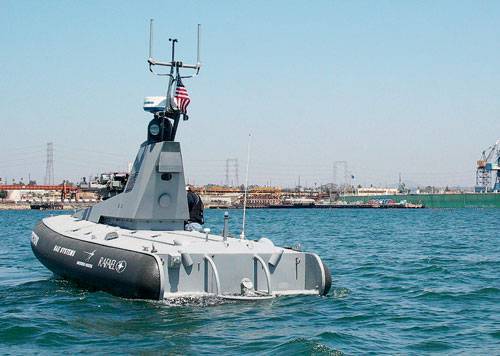
Rafael Protector (Israel)
Length: 9 m // Engine: diesel // Speed: 50 nodes (92,6 km / h) // Navigation: radar, GPS and INS (inertial navigation) // Armament: the Mini Typhoon automatic system, which allows you to install a machine gun of 7,62 caliber mm or 40-mm grenade launcher. Israeli development is an unmanned boat. The main advantages of the “defender” include high maneuverability and the ability to work with a wide range of strategic tasks without endangering personnel. First of all, the protector is designed to carry out anti-terrorism missions; he is able to independently detect, identify and hit the target within the specified source data
Brief introduction to the topic
Nikola Tesla was not a mere idealist. He patented his own invention called “Methods of control and control devices for radio-controlled swimming facilities and wheeled vehicles”. Moreover, he made an experienced copy of the drone boat. The boat of length 1,8 m was equipped with an electric motor with a battery, a receiver for radio signals and a lighting system. Tesla did not provide any “stuffing”, intending to sell the drone to the military ministry for use as a firefighter. That is, the boat, according to Tesla, was loaded with dynamite and could sink an enemy ship like a torpedo. The government rejected the idea of the scientist - and in vain.
They returned to the topic of unmanned watercraft during the Second World War - of course, it was not without German technical genius. A fairly well-known German drone of those times was a self-propelled Goliath mine, controlled at a distance and capable of carrying up to 100 kg of explosives. In 1944, the first radio-controlled firemen Ferngelenkte Sprengboote were made. True, it did not come down to their wide use.
Actually, pre-war sentiments and the war itself spurred the development of the theme of “inhuman” weapons. In the USSR, experiments on the development of teletankov were in full swing, and in the Soviet-Finnish war, the remote-controlled models TT-26 and TU-26 were even used in combat operations. The main problem of the teletanka was the practical impossibility to provide aimed fire. At the same time, in Canada, Comox developed a remote-controlled torpedo, in the United States and France, work was also underway to create unmanned missiles and torpedoes.
In the 1950, during the Cold War, work did not stop for a minute. The development by the US military of a successful remote-controlled mine sweep Drone in 1954 pushed the US military to create a number of unmanned swimming vehicles designed for the same purpose on the water: “High-speed maneuverable sea mine sweep”, as well as QST-33, 34, 35A Septar projects. Radio-controlled demining boats were also built in Denmark (Stanflex-3000), Japan (Hatsushima class), Sweden (Sam-II ACV), Great Britain (Rim) and Germany. So, a start was made. We will try to analyze how things are in the market of unmanned warships today.
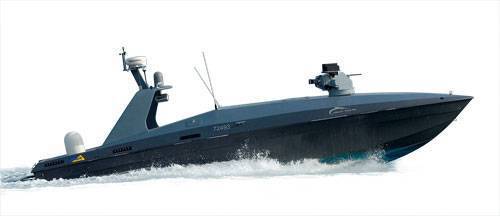
Elbit Silver Marlin (Israel)
Length: 10,67 m // Platform weight: 4000 kg // Payload: 2500 kg // Maximum speed: 83 km / h // Uninterrupted operation time: 24 hour // Laser guidance system: detect a small boat - 6 km, detect a large boat ship - 16 km, aircraft detection: 15 km // Range: 800 km // Armament: 7,62-mm machine gun, ability to shoot in motion. The Elbit Silver Marlin unmanned boat is able to patrol territory up to 500 km in autonomous mode. The appointment of "Silver Marlin" can be very different. This is intelligence, observation and reconnaissance; protection of transport vessels from terrorist and piracy threats, detection and elimination of sea mines, search and rescue operations. You can believe it: Elbit Systems is today the leading global company for the production of unmanned platforms
American Dream
Leading developers and manufacturers of unmanned military boats today are the United States and Israel. In both countries there are a number of programs aimed at the creation and improvement of drones. The most serious of the US is the Draco project, which has been developed by General Dynamics Robotic Systems (GDRS) since 2006. Draco was conceived as a multiplatform for a number of unmanned vehicles, allowing to perform missions of various kinds.
At the moment, on the basis of the Draco USV System, four types of unmanned boats have been developed: a lowered sonar, a towed sonar, a universal workhorse and a rocket boat. True, the latter has not yet been manufactured "in metal", but exists only in the design version.
Management of any of the boats can be carried out by various methods, depending on environmental conditions and the combat situation. Firstly, it is radio control in direct line of sight (like a toy car), secondly, control via satellite, and finally, control via an unmanned aircraft that serves as high-altitude "eyes" Robot. The Draco is powered by two Yanmar 6LY3A-STP powertrains coupled to Kamewa FF310 liquid-propellant jet engines, similar to racing hydroplanes. The software and numerous sensors allow the boat to automatically avoid obstacles, as well as warn the operator of a change in the outboard situation. Among other things, the Draco's modular construction - like a Lego constructor - provides for the installation of more advanced control systems and weapons when they are developed.
Marine Robotics Vessels International (MRVI) at an exhibition in Abu Dhabi in 2007 introduced a 6,4-meter unmanned boat Interceptor-2007. Unlike the workhorse Draco, the MRVI is primarily designed to perform various missions at high speeds. Claimed top speed drone, 87 km / h, is a pretty serious indicator for water, and the manufacturer claims that this is just the beginning. Interceptor is designed to perform reconnaissance functions, as well as to protect large transport ships. In the latter case, it can be equipped with a water cannon or non-lethal weapons such as light dazzlers. True, there is some slyness in such statements. If the Interceptors go into production, their armament will most likely be machine guns or rocket launchers.
Some projects that were successful at first glance remained unrealized due to serious competition between the developers. The customer is the same for all - US Navy, and if the naval department refuses to finance the project, it simply closes.
An example is the Spartan Scout unmanned boat from Radix Marine. It was developed back in the 2002 year and was constantly being refined - right up until recently. The boat with a length of 11m was equipped with a radar and video camera system, as well as an electro-optical aiming system if necessary to install weapons on it. It was supposed to install 13-mm machine guns AGM-114 Hellfire or rocket system FGM-148 Javelin. In 2003, the first Spartan prototype was made, which is very easy to use and has a high degree of autonomy: a team of just two men launched it from the Gettysburg cruiser. Radix Marine designed and manufactured two samples with a load capacity of 2267 and 1360 kg; a larger version was tested. The boat proved to be a good idea, but for some reason the Ministry of War stopped active support of the project. To date, even the company's website has disappeared from the Internet, the fate of the boat is unknown.
If we forget about the many projects that have slowed down at the development stage, it is worth noting another company that brought its unmanned boat to its embodiment in the metal. This is a Boston Whaler - a famous manufacturer of tourist yachts and boats. Together with several other electronics and radar equipment manufacturers in 2008, Boston Whaler presented to the public two models of unmanned boats under the brand name of the parent company Brunswick. First of all, the manufacturer sought to interest the new military, but so far this experiment has not brought results. And the boats came out, by the way, beautiful.
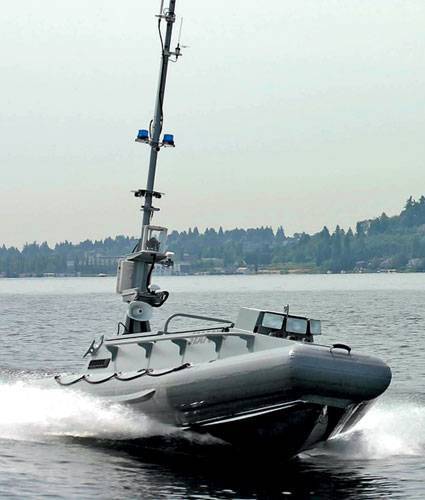
Seafox (Seattle, United States)
Unmanned boat Seafox developed by Northwind Marine (Seattle, USA) for the purposes of surveillance and patrolling. The inflatable boat with an aluminum frame is compact enough (5 m in length) and light, it can be transported in the confined space of the hold of the ship-uterus and deployed in a matter of minutes. Guidance System was developed by Northwind Marine experts to control any unmanned vehicles, both waterborne and land vehicles. There is a second modification of the boat - Seafox Mark II, equipped with seats for four passengers. It is heavier than the Mark I, and is intended for rescue missions. The illustration - Seafox Mark I
Children of Israel
The leading Israeli arms manufacturing company, Rafael Advanced Defense Systems Ltd, established over 60 years ago as a division of the Ministry of Defense, and in 2002, it became an independent company. Rafael manufactures warheads, torpedoes, ground equipment, computer detection systems - all that the soul of the militarist wishes. In 2007, the company launched the Protector unmanned boat into mass production. Today it is the only unmanned combat boat in the world, which is produced by industrial series and is officially in service.
Protector was designed as an anti-terrorism platform with a very high level of autonomy. Ideally, a person should not take part in the work of the “Defender” at all; the maximum is to control a dozen boats simultaneously, looking at the monitors and at the telemetry data. In the open sea, a boat, of course, cannot fight, but for coastal and river operations it seems to be the ideal weapon. The Defender is equipped with an electro-optical aiming system (Rafael's know-how) and a heavy 7,62-mm machine gun Mk 49 Typhoon mounted on a pivot bearing. The boat can independently choose targets and destroy them, but most often the machine gun is controlled by a human operator, regardless of the Defender. Today, the company successfully trades in "Defenders": the boats are acquired not only by the Israeli army, but also by the armed forces of Singapore and the US Navy. It should be noted that the Americans took part in the development of the Protector - in particular, Lockheed Martin provided some assistance.
In connection with the production of "Defender" on the conveyor in the world community have arisen numerous disputes and debates. The main issue was the responsibility for the weapon installed on the boat, and for possible victims in the event of its successful use. Who will be guilty: the pilot of the boat, the operator of the machine gun, the commander of the detachment of drones, the manufacturer of the boat? And maybe no one? After all, in automatic mode, the boat itself decides whether to attack or not. The question still remains unresolved. However, for two years of work, Protector has not yet killed anyone, so there have been no precedents. In the US, "Defenders" is still just being tested, not hurrying to put a new product into service.
In addition to Raphael, several Israeli companies have developed their projects for unmanned boats. We should also mention the company Elbit, which presented the Silver Marlin automatic boat in 2007 year. Actually, from Elbit similar development was expected much sooner than from Rafael. Still, Elbit specializes in unmanned aerial vehicles - multi-purpose and reconnaissance UAVs of this company are always successful at exhibitions and in demand.
Silver Marlin is already on the conveyor, although there are not so many orders from Elbit. The ten-meter boat is designed to carry out missions for patrolling, detecting and destroying various types of targets, protecting against piracy and terrorists, there are also mine and rescue modifications. The range of the boat - 500 km; it is equipped with a 7,62-mm machine gun and a laser aiming system. Detection of another ship is possible at a distance of about 15 km. What is the reason for the less famous Silver Marlin? In the laws of the market. The company Rafael simply had time to advance its development.
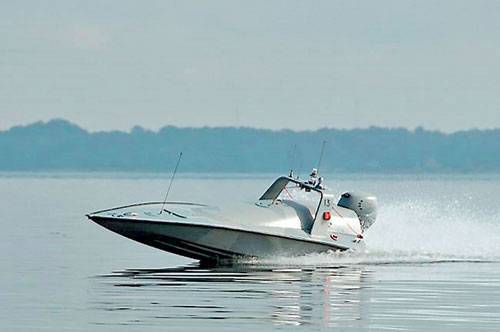
SAM 3 (Sweden)
The third country - a manufacturer of waterfowl drones after Israel and the USA can be called Sweden. Kockums, one of the world's largest shipbuilding companies, has been developing and testing Piraya (piranha) unmanned boats since 2002. “Piranhas” - small and light, only 300 kg in weight and 4 m long - are intended for use in reconnaissance, but not for combat purposes (although equipped with light machine guns). On the same technological base, kockums serially produces already adopted drones - minesweepers SAM 3. The first SAM was developed in 1982 year, and the modern model is the triumph of military technology. According to the principle of the SAM 3 is no different from the usual minesweeper with a human team. But it is fully automated, able to independently find and collect sea mines, while not putting people at risk
Who needs drones?
To cover the entire modern market of unmanned combat boats in one article is simply impossible. In principle, almost all developments are like two drops of water, and they left Tesla's patent a hundred years ago only due to the development of computer systems and technologies. There is nothing revolutionary new.
Who may need drones, and why do the military departments so reluctantly address this topic? Stephen Phillips, managing director of the British company Autonomous Surface Vehicles, answered this question with a fair amount of skepticism: “To be honest, today there is no need to use expensive unmanned boats. Why invent a bicycle if patrols are much better done by boats equipped with a professional team? For the needs of passive defense, they are quite enough. Yes, of course, there is a need for radar, surveillance cameras - but they can be placed on the shore. Unmanned boats will be needed in the event of a start of serious hostilities and a real danger to human life, but as long as the situation is stable, they can wait in reserve ... "
It is difficult to say whether Israel will take the initiative of other states. Singapore has already purchased a number of deadly UAVs. The United States is preparing for this, but practically nothing is heard about the others. Although the existence of the “first swallows” - Rafael and Elbit– suggests that sea battles without human participation have a great future ...
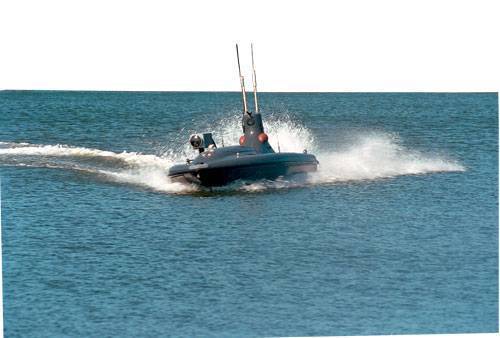
OWL MK II (USA)
Unmanned boat, developed by the American company Wamilton. Unlike its more advanced competitors, Owl (“Owl”) requires mandatory operator control. The distance from the operator is about 15 km. At the end of 2010, a demonstration of "Owls" is scheduled to the US Department of Defense. Owl length - 3 m, width - one and a half. The main intended purpose of the drone is to transport a video camera, sonar or listening device, that is, reconnaissance targets. Boat speed - up to 40 knots (75 km / h). Today, a more sophisticated design of the boat is being developed, capable of receiving commands from a satellite and not needing an operator who “hides somewhere nearby”
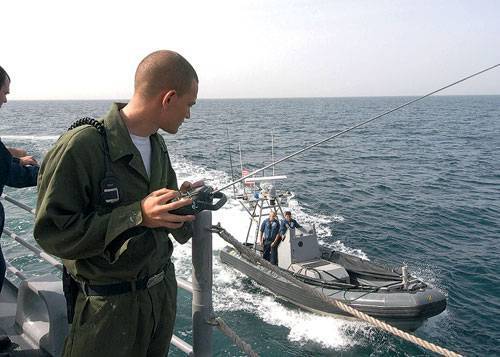
In 2005, the American company international developed and widely advertised a system that allows you to turn almost any boat of suitable size into an unmanned reconnaissance vehicle. The kit included microphones, video cameras, radar, sonar, global positioning system, equipment for the operator and the corresponding software. The first development was directed against the spread of piracy in the coastal waters of Asia and Africa. A great idea was not viable - the production system was minimized.
Information